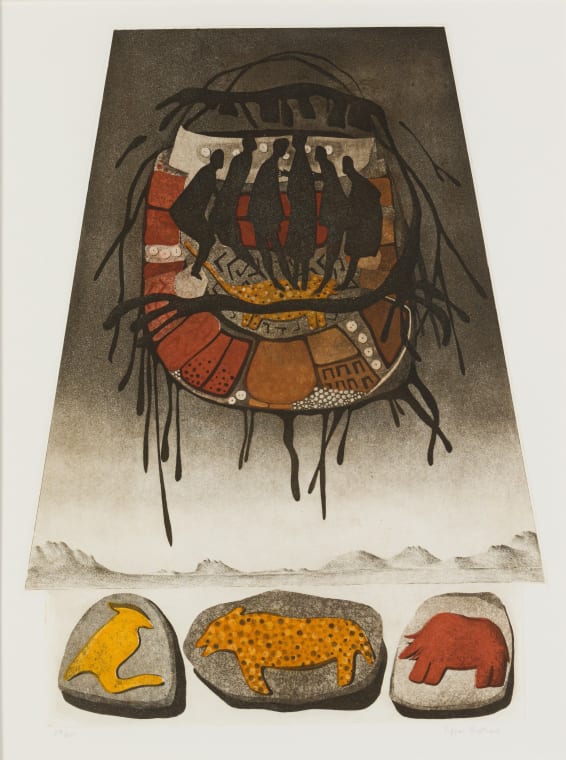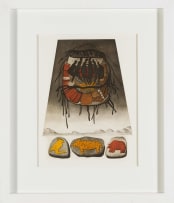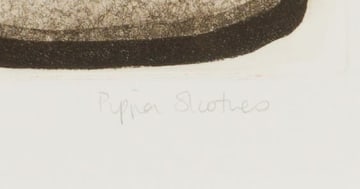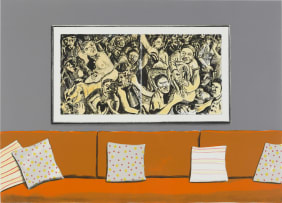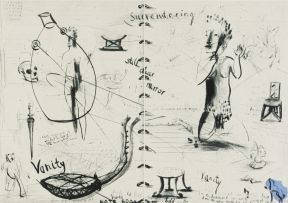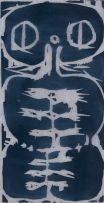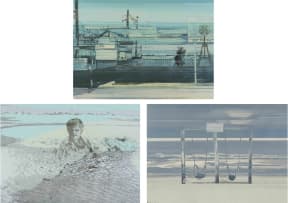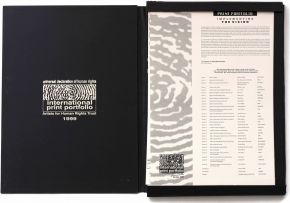Modern, Post-War and Contemporary Art, Decorative Arts, Jewellery and Wine
Online-Only Auction, 15 - 22 February 2021
Prints and Multiples
About this Item
signed and numbered 29/60; dated 1990 and inscribed with the artist's name, the title and the medium on a Finansbank note adhered to the reverse
Notes
Pippa Skotnes produced this colour etching in 1990 as part of an edition of 60 prints, using two copper plates and the finest French Charbonnel ink on 100% rag Fabriano Tiepolo paper. An earthy array of yellow ochre, umber and sienna resurrect the rich cultural history of the |Xam people of South Africa and their trade interactions with early settlers. The colours Skotnes uses and the visual qualities she achieves recall the imagery characteristic of rock paintings found across Southern Africa.
Born in Johannesburg in 1957, Skotnes currently lectures in curatorial studies at the Michaelis School of Fine Arts, University of Cape Town, and is the director of the Centre for Curating the Archive, which she helped found in 1996. In her art practice, Skotnes frequently brings to the fore the largely overlooked and underrated histories of the early indigenous people of South Africa, such as the |Xam and !Kung, pejoratively referred to during the colonial era as the 'bushmen' or more broadly as the 'San'.
In lot 358, a group of six figures is depicted in the act of communication, possibly referring to the forms of communication that took place between the human and spirit worlds during the trance dance, a ritual enacted as part of the belief systems of indigenous communities such as the |Xam and !Kung. The ingestion of potent hallucinogens and the energetically performed dance led performers into a trance state that served as a mediation point with the spirit world.
The group is shown here enclosed by a tasselled leather bag of the sort that was used by the nomadic San to carry their belongings and which was representative of wealth, and perhaps the superimposition of these two images in this artwork refers to both spiritual and material prosperity.
Below the bag are images of a bird, a spotted animal and an elephant, all individually placed on stones. These could refer figuratively to specific spirit and rain animals in the San belief system, as well as literally to items such as ostrich feathers, skin and ivory that were traded between the |Xam and the settlers in exchange for tobacco. A |Xam informant interviewed during the 19th century expressed his community's love of tobacco, as referenced in the title of this artwork, We are Smoking's People. The foreground images are offset by an 'empty' mountain landscape in the background, which may speak directly to the historical context when colonial authorities regarded the interior of South Africa as unsettled and therefore available for appropriation, and indigenous communities were forced off the land their livelihoods depended upon.
The artist's technical expertise creates a visual texture that is comparable to the grainy textures of stone and sand and imparts a sense of aridness appropriate to the harsh natural and political contexts that necessitated survival.
The precisely curated symbolism and careful attention to detail in this work not only demonstrate Skotnes's fine workmanship but also encourage thought provoking questions about South Africa's early colonial history and the fate of its indigenous peoples.
Jordan Anthony
